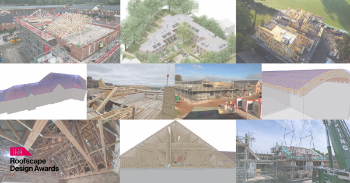Inspecting stone sample panels
Selecting the correct stone is arguably the most important part of a project and presents the best opportunity for avoiding potential problems in the future. This article considers the specific but important issue of what to look for in a stone sample panel. While this may seem like a very niche topic, it affects much of the selection process and so deserves more in depth discussion.
The mine or quarry that stone is sourced from should have range/control panels showing the geological characteristics typically found in the various beds available (shown below). This provides the customer with the truest indication of the variation they can expect to find in stone from the bed they are using. This is vital to the effective management of customer expectations as stone is a natural material and not every piece will look the same. If this is understood then the unique aesthetic that natural stone provides can be celebrated and built into the design rather than cause tensions between the quarry and the customer.
Ultimately it is the quarry or mine’s responsibility to select a suitable number of samples from the chosen bed to show the typical range of geological variations that are present, but if the production company has already been and selected the stones and the blocks are all in stock and available for a pre-purchase, then this can be completed at their works instead.
Inspection should take place at the extraction site, but if this is not possible, then confirmation that the quarry has been closely consulted in the sample selection must be sought.
The range/control panels from the different quarries and beds should be carefully inspected and then the final selection made and high resolution photographs taken for future reference.
The rejection of geological characteristics naturally found in the stone will typically result in increased costs and prolonged procurement through abortive cutting and will increase wastage and carbon footprint and so the overall sustainability of the supply.
Any comparison between the range/control samples and the actual production should be carried out in normal daylight for external stone work or perhaps similar light conditions to the project for internal works. Wherever possible, samples should be viewed from a distance of 2m as stated in all the relevant British Standards and in the orientation in which the stone will be used.
--Stone Federation Great Britain
[edit] Related articles on Designing Buildings Wiki
- 2016 Natural Stone Awards.
- Choosing stone.
- Defects in stonework.
- Kentish ragstone.
- Limestone for building.
- Natural stone.
- Natural stone cladding.
- Natural Stone for Interiors.
- Natural stone tiles.
- Portland Stone.
- Surface Design Show 2017.
- Sustainable stone.
- Types of stone.
[edit] External references
- Stone Federation, Selecting the Correct Stone.
Featured articles and news
Moisture, fire safety and emerging trends in living walls
How wet is your wall?
Current policy explained and newly published consultation by the UK and Welsh Governments.
British architecture 1919–39. Book review.
Conservation of listed prefabs in Moseley.
Energy industry calls for urgent reform.
Heritage staff wellbeing at work survey.
A five minute introduction.
50th Golden anniversary ECA Edmundson apprentice award
Showcasing the very best electrotechnical and engineering services for half a century.
Welsh government consults on HRBs and reg changes
Seeking feedback on a new regulatory regime and a broad range of issues.
CIOB Client Guide (2nd edition) March 2025
Free download covering statutory dutyholder roles under the Building Safety Act and much more.
AI and automation in 3D modelling and spatial design
Can almost half of design development tasks be automated?
Minister quizzed, as responsibility transfers to MHCLG and BSR publishes new building control guidance.
UK environmental regulations reform 2025
Amid wider new approaches to ensure regulators and regulation support growth.
The maintenance challenge of tenements.
BSRIA Statutory Compliance Inspection Checklist
BG80/2025 now significantly updated to include requirements related to important changes in legislation.
Shortlist for the 2025 Roofscape Design Awards
Talent and innovation showcase announcement from the trussed rafter industry.
























